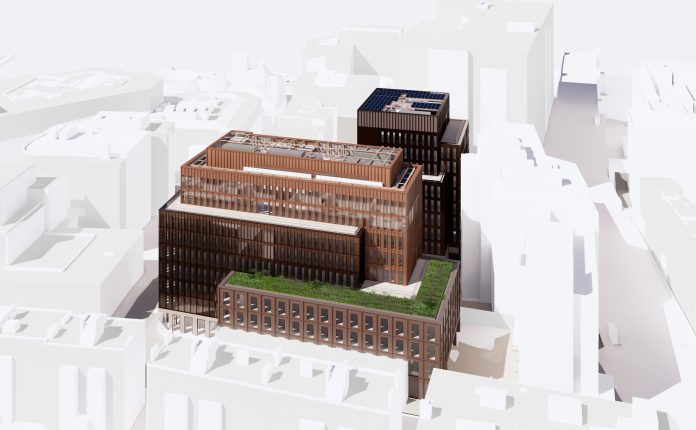The Centre for Digital Built Britain, as part of the Construction Innovation Hub, is supporting a ground-breaking commercial development. Thayla Zomer, a research student embedded in the project team, reports on her work assessing the benefits to industry of applying Modern Methods of Construction and a digital delivery approach to a commercial development
The construction site in Southwark, London, where two nine-storey offices, known as The Forge, are being developed does not look very different to any other building plot – but appearances can be deceptive. What is taking place at this 140,000sq ft development has innovation and digital tools integrated throughout every stage of the project, from design and procurement to construction and delivery.
While government adopted a presumption in favour of offsite manufacturing technologies as part of a transition to Modern Methods of Construction (MMC) and new business models, The Forge marks the first time design for manufacture and assembly (DfMA) and platform design for manufacture (PDfMA) has been applied to a commercial development. The “platform” uses a standardised and componentised approach to construction that essentially creates an onsite “kit of parts” assembly line.
The initiative features collaboration between partners Landsec (developer and lead partner), Bryden Wood (designer) and Easi-Space (prototype engineering and consultancy), with contractors Mace and Sir Robert McAlpine working in partnership as the manufacturing and assembly managers (MAM).
This is a highly innovative partnership and the Centre for Digital Built Britain (CDBB) and the Construction Innovation Hub (CIH) will be mapping the processes and evaluating whether they are delivering the expected benefits and the project learning will also be used to inform and refine the Construction Innovation Hub’s Platform Design Programme.
Learning from real experience
As the appointed researcher, I have been embedded as part of the project team from the start of the detailed design, with the aim of exploring the transition to digitally enabled manufacturing – the adoption of a platform strategy and digital system integration as a new business approach; changes in project delivery (processes and technological innovations); and the impact of integrating platforms, DfMA and digital technologies on project performance.
The project partners have successfully built a prototype model at Bryden Wood’s Construction Platforms Research Centre in Petersfield, Hampshire, and the learnings from this exercise are now being applied at scale.
This ‘live’ trial of a platform is designed to deliver more consistency to the process of design and build with the aim to increase productivity, safety, accuracy and quality, decrease waste and embodied carbon, and reduce costs by as much as a third when applied to the whole build. Targets set for The Forge include a 10% cost saving, a 15% reduction in programme time, and a 35% improvement in onsite productivity.
This is an opportunity to learn from real experience. The integrated digital approach taken at The Forge establishes a new form of collaboration between a multi-skilled team drawn from different disciplines in order to capture a system view of the project, in contrast to a traditional linear approach often led by a single manager.
The principles of digitally enabled manufacturing have been adopted, with the production of information models and the use of a range of technologies creating a digital chain across all of the stages of the project to design, procure, build and check the building.
My research will record and analyse the success in use of each of the integrated tools contributing to the project’s learning legacy for industry. Changes in processes and workflows are studied, mapped and compared with the traditional delivery approach. At the end of the project, the team will be able to reflect on the workflows adopted and identify how they can be optimised to deliver greater value to new projects.
The P-DfMA approach, supported by digital technologies, requires a change in the way in which the work is planned and the sequencing of activities. To address this, the project team developed a more integrated way of working.
For example, in the early stages of the project, the BIM Execution Plan developed by the project team did not only incorporate suppliers’ methodology for delivering the project using BIM and digital technologies as in the usual delivery approach, but it incorporates both the BIM and DfMA implementation strategies. A digital delivery approach has been developed by the MAM team, and a model development strategy has been put in place considering the DfMA rules applied. A holistic design process has also been adopted encompassing how structure and objects will be manufactured, assembled and guided with DfMA principles.
A number of innovative tools have been used and the project team has worked on how to integrate these different tools to achieve project objectives. For example, the team has focused on the identification of the outputs of each tool that should be monitored and reported by Power BI (a tool used for better visualisation and data management). The team has identified the measures and data from the tools (eg Qflow, T+ and Disperse) that will be used for monitoring (eg compliance of models) and that could give insights into what is happening, also allowing to track the productivity across the stages.
The use of such technologies is also particularly useful given the current Covid-19 situation. If the team is working remotely, they will be able to have access to the site and visibility of issues to discuss in real time, enhancing decision-making while saving time and resources.
Assessing benefit of combining P-DfMA and digital tools
The project benefits will be assessed across a range of impact pathways to measure: time savings; materials savings; cost savings; environmental impacts; improved health and safety; and reduced risk.
The framework takes a system approach that captures the dynamic processes within the project as a whole, avoiding a silo perspective that brings limited focus to the assessment of one aspect in isolation. By measuring the benefits of combining MMC and digital technologies in an integrated way, it will be possible to establish new benchmarks on productivity and showcase to the whole industry the value of these innovations.
Thayla Zomer
Research student
Centre for Digital Built Britain
Twitter: CambridgeCDBB
LinkedIn: CDBB














